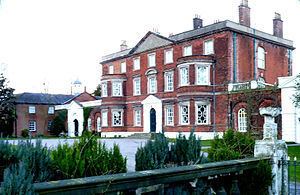OS grid reference SJ 654 783 Built for John Smith Barry Reference no. 57568 | Built 1755 Designated 4 March 1969 Opened 1755 | |
 | ||
Similar Marbury Hall - Anderton, St Mary and All Saints' C, Brereton Hall, St Martin‑in‑the‑Fields, Marbury Park | ||
Belmont Hall is a country house one mile (1.6 km) to the northwest of the village of Great Budworth, Cheshire, England. It is recorded in the National Heritage List for England as a designated Grade I listed building. The house stands to the north of the A559 road. It is included in Simon Jenkins' England's Thousand Best Houses, and as of 2013 is occupied by Cransley School.
Contents
History
The site for the house was bought in 1749 by John Smith Barry. He commissioned James Gibbs to design the house, which was completed in 1755. Gibbs died in 1754, therefore the house's construction was probably supervised by a local architect. Some of the architectural features of the house are inconsistent with Gibbs' work elsewhere, and it is considered by de Figueiredo and Treuherz, and by Hartwell et al. that changes to the design, including the two-storey bow windows, were made by the executant architect. When John Smith Barry died in 1784 the house was inherited by his son James Hugh Smith Barry, an art collector. At his death in 1801 the house was sold to Henry Clarke, who sold it to the Leigh family. As of 2012, the estate was still in the ownership of the Leigh family, the house being let to Cransley School, and part of the surrounding land being used as a registered site by the Camping and Caravanning Club.
Exterior
Belmont house is constructed in brick with stone dressings on a stone plinth, and it has a slate hipped roof. It is designed along Palladian lines, with a central block of living rooms, separate side pavilions for offices, stables to the west and kitchens on the east. The central block has a symmetrical front, it is in three storeys, and has seven bays. The central doorway is flanked by rusticated stonework. It has a fanlight with a round arch, above which is a pediment. The lateral two wings have semicircular two-storey bay windows, which are in a different style from the rest of the house. The central pane of each window is octagonal. The other windows in the lower two storeys are 12-pane sashes, and those in the top storey are 12-pane casements. Around the top of the house is a moulded cornice, a plain parapet, and a central three-bay pediment containing the coat of arms of the Smith Barry family and their motto. The right pavilion is in two storeys and three bays with 12-pane sash windows. It has a pedimented gable facing the side of the house, and a hipped roof with a cupola. The left pavilion has been rebuilt in a simpler form. Each pavilion is joined to the house by a wing wall containing a central round-arched pedimented doorway and two 12-pane sash window, and is topped by a vase balustrade.
Interior
The ground floor originally contained six rooms; clockwise from the doorway they are the entrance hall, two drawing rooms, the staircase hall, the dining room, and a study or morning room. An extra room was added in the 19th century. The entrance hall is relatively plain, with a stone fireplace and pulvinated friezes over the doors. The study is panelled, and contains doorcases, a chimneypiece and an overmantel all of which are carved with flowers and fruit. The drawing rooms contain fine Rococo plasterwork on both ceilings, and on the walls and the chimneypiece of the front room. Hartwell et al. describe the plasterwork as being "quite sumptuous and exceptionally delicate". In the staircase hall is a panel between the windows containing a bust of Diana, with decorative plasterwork including festoons and hunting trophies. In the upper floor, the southwest room is decorated in Chinoiserie, including pagodas, trellises and birds. Both Hartwell et al. and de Figueiredo and Treuherz argue that the plasterwork must be by Francesco Vassilli, who had worked elsewhere with Gibbs.
Surrounding buildings and grounds
In the grounds are a moat, a fishpond, kitchen garden and formal lawns. The moated site and the fishpond are designated as a scheduled monument. The two lodges at entrances to the drives are listed at Grade II. Both are constructed in brick with stone dressings and slate hipped roofs. Their fronts are symmetrical, with Tuscan porches, and 12-pane sash windows.
